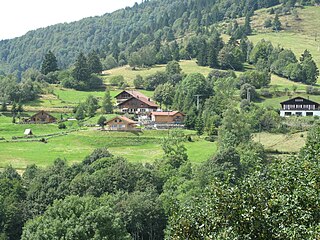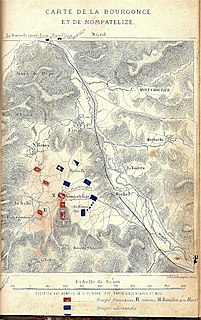
Vosges is a department in the Grand Est region in Northeastern France. It covers part of the Vosges mountain range, after which it is named. Vosges consists of 17 cantons and 507 communes, 273 of which are classified as urban and of which 234 are classified as rural, including Domrémy-la-Pucelle, where Joan of Arc was born. In 2017, it had a population of 367,673 with an area of 5,874 km2 ; its prefecture is Épinal.
Celles is the name of several places:

The Vosges are a range of low mountains in Eastern France, near its border with Germany. Together with the Palatine Forest to the north on the German side of the border, they form a single geomorphological unit and low mountain range of around 8,000 km2 (3,100 sq mi) in area. It runs in a north-northeast direction from the Burgundian Gate to the Börrstadt Basin, and forms the western boundary of the Upper Rhine Plain.

Raon-l'Étape is a commune in the Vosges Department in Grand Est in northeastern France.
Sainte Barbe is French for Saint Barbara.
Longchamp or Longchamps may refer to:
Fosse a ditch or moat, may also refer to:

Cornimont is a commune in the Vosges department in Grand Est in northeastern France.

Bruyères is a commune in the Vosges department in Grand Est in northeastern France.
Neufchâteau may refer to:
The Seventh Army was a field army of the French Army during World War I and World War II.

Bulgnéville is a commune in the Vosges department in Grand Est in northeastern France.

Charmes is a commune in the Vosges department in Grand Est in northeastern France. It is located on the river Moselle and the Canal de l'Est.

Mariano Francisco Julio Goybet was a French Army general, who held several commands in World War I.

The Fortified Sector of the Vosges was the French military organization that in 1940 controlled the section of the Maginot Line at the northern end of the Vosges Mountains in northeastern France. The sector was bordered to the west by the Fortified Sector of Rohrbach and to the east by the Fortified Sector of Haguenau. The sector featured two gros ouvrages mounting heavy artillery at either end of the sector and one petit ouvrage mounting infantry weapons, linked by a line of casemates. The sector was attacked in 1940 by German forces in the Battle of France. German forces penetrated the casemate line and moved behind French lines. Despite the withdrawal of the mobile forces that supported the fixed fortifications, the three ouvrages successfully fended off German assaults before the Second Armistice at Compiègne, but were unable to hinder German activities to their south. The positions and their garrisons finally surrendered on 1 July 1940. Following the war several positions were reactivated for use during the Cold War. One position, Ouvrage Four-à-Chaux, is open to the public and may be visited.
Battle of Vesontio may refer to:

The Battle of Nompatelize, also known as the Battle of Etival, was a battle of the Franco-Prussian War on October 6, 1870, between Etival and Nompatelize in the province of Vosges from Strasbourg 64 km southwest. This battle marked the first major crackdown of franc-tireur operations in the Vosges region by the XIV Corps of the Prussians by Minister August von Werder in early October 1870. In matches fiercely this, A force of the Army of Rhône of the French Republic under the command of General Louis-François Dupré, who predominated to markedly document in terms of troop numbers, and attacked 6 infantry batallions of the Grand Duchy of Baden under the command of General Alfred von Degenfeld which were part of the XIV Corps, but were defeated. Compared to the casualties of the German military, the losses of the French side in this battle were much greater. After seven hours of fighting, the French were forced to flee in turmoil to Bruyeres and the Rambervillers. The Battle of Etival contributed to General Werder wiping out the French from Alsace.
This page is based on this
Wikipedia article Text is available under the
CC BY-SA 4.0 license; additional terms may apply.
Images, videos and audio are available under their respective licenses.









